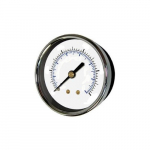
- Show results for
- Share
Liquid-filled vs. Dry Pressure Gauges
Resource Description

Pressure gauges are widely used in a wide range of applications. For example, in the production process, it is often necessary to control the pressure of liquids, steam, and gas. Depending on the specialization of the enterprise, there is a need to measure different environments. For this purpose, various pressure devices have been developed.
Overall, there are two main types of pressure gauges - liquid-filled and dry. You may ask: what is the difference between them? As usual, Mega Depot has an answer. Read the information below to find it out.
Dry or Liquid-Filled Pressure Gauge?
Due to the mechanism that converts the deformation of the sensing element into rotational movement, the hands with a dial are sensitive to vibration and pressure drops (sudden increase/decrease in pressure). This problem can be solved by filling the case with liquid. Therefore, when choosing a pressure gauge, you should ask yourself whether you need a dry or liquid-filled type.
Dry pressure gauges do not contain liquid.
Popular Products
Benefits:
- Dry gauges are cheaper than liquid-filled devices.
Disadvantages:
- They are not protected from vibrations and pressure drops that can disable the mechanism.
- They are not suitable for cold and humid conditions, as the humid air inside the pressure gauge housing can freeze and damage the mechanism.
Application:
More economical, dry gauges are preferred for simple applications where vibration is not a problem. They are often used, for instance, on air compressors.
Liquid-Filled Pressure Gauges are filled with a liquid (usually pure glycerin or a mixture of water and glycerin) that acts as a damper for vibrations and pressure drops.
Popular Products
Benefits:
- Liquid-filled pressure gauges are more resistant to vibration and pressure drops.
- They are sealed, as they prevent moisture from entering the case and blocking the mechanism.
- These pressure gauges can function at sub-zero temperatures.
- They are environmentally friendly as the liquid (glycerin) is non-toxic and degradable.
Application:
Liquid-filled pressure gauges are used in humid and cold environments or high-vibration conditions.
Read Before Buying/Using a Pressure Gauge:
- A pressure gauge filled with pure glycerin can work at temperatures down to -23°F. At temperatures below 62,6°F, glycerin becomes viscous (slows down the mechanism), and at -23 °F the device stops functioning.
- At low temperatures, a mixture of glycerin and water is used, which allows reaching -50,8°F.
- It is recommended that permanently installed pressure gauges are placed face-up on the shade side so that the scale does not fade in the sun.
- Do not operate the device within the permissible measurement limits, i.e. in places where this limit can be exceeded.






